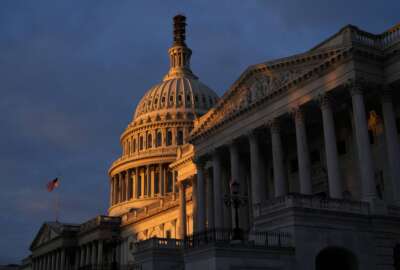The National Security Agency will announce a reorganization of its structure in January, revamping the foreign intelligence entity for the 21st century.
NSA Director Adm. Michael Rogers said the agency will undergo its most comprehensive set of changes since the late 1990s in the form of an initiative called NSA21.
While Rogers said he wanted to give his employees all the details first, he did divulge some parts of the plan during his Dec. 15 speech at an Intelligence National Security Alliance event in Arlington, Virginia.
“We have spent the last literally 10 months or so at NSA, answering the following question. This is what I posed to the senior leadership out at Fort Meade [Maryland]: ‘I believe NSA is the preeminent signals intelligence and information assurance organization in the world. No one can do what we do on the global scale against the most … advanced technologies. But, shipmates, if we do nothing and we keep doing things the way we always have been, are we going to be able to say that five to 10 years from now?’” Rogers said.
He added that he believed as a leader his job is not only to ensure NSA is optimized for success today, but it is optimized for success in the future.
Rogers said the changes were based on major areas that will prepare the agency for the years ahead. One of those areas focuses on collaboration and partnership within the agency and with industry.
“NSA has created some amazing cylinders of excellence, but at times there are blocks of granite between those cylinders,” he said. “We have got to learn what it means to collaborate and partner internally every bit as much as we reach out to the outside world for a broader set of partners.”
Rogers said NSA needs to harness the innovation of industry more than it does now. He said that NSA’s current interactions with industry are mostly to augment the workforce in key business areas where additional capacity is needed or to provide assistance in support functions.
Key mission capabilities were developed by NSA internally. Rogers said that thinking does not optimize NSA for the future.
“When I look at where the engines of innovation are, when I look at where the greatest rate of change is, I don’t see that in the government sector, I see that in the private sector,” Rogers said. “How do we create a framework that enables us to work with the private sector in a much more integrated way than we have historically done?”
Rogers said he wants to bring in industry for more important mission capabilities. He also wants to create a model where people who work in government go to industry and then come back to the government, or for people who have worked in industry for a long time and want to come to the government.
“I run into this all the time out in [Silicon] Valley. I will have people approach me and say ‘Hey admiral, I’ve been working IT out of here for 10, 20 years. I’ve made a lot of money, my children are now in college … I’d really like to pay back a little bit … is there a way for me to potentially be a part of your structure?’ Traditionally, we’re just not quite optimized to do that,” Rogers said.
Rogers said that instead NSA and U.S. Cyber Command are set up for recruiting young people for lifelong careers.
In addition to collaboration, Rogers said the other cruxes of the policy revolve around employee development, innovation and the organizational structure that is needed to implement the new goals and to manage global threats.
While NSA is preparing for a change, Rogers made clear that the reorganization would not merge any of the functions of the two entities he manages — CYBERCOM and NSA.
Rogers told lawmakers that he was soliciting employee input for the reorganization back in September. He told the Senate Armed Services Committee that he was receiving a review of employee suggestions on Oct. 1.
Rogers said during the hearing those recommendations would be used to inform his reorganization decisions. He also said he wanted the entire workforce to be involved in the evolution of the agency and did not want the reorganization to come from just the leadership.
The three areas Rogers asked for recommendations on came from a previous batch of more than 200 suggestions from employees.
Copyright
© 2024 Federal News Network. All rights reserved. This website is not intended for users located within the European Economic Area.
